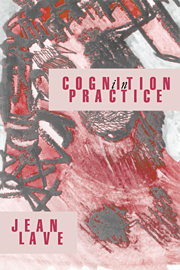Book contents
- Frontmatter
- Contents
- List of figures
- List of tables
- Preface
- 1 Introduction: psychology and anthropology I
- PART I THEORY IN PRACTICE
- PART II PRACTICE IN THEORY
- 5 Inside the supermarket (outdoors) and from the veranda
- 6 Out of trees of knowledge into fields for activity
- 7 Through the supermarket
- 8 Outdoors: a social anthropology of cognition in practice
- Notes
- References
5 - Inside the supermarket (outdoors) and from the veranda
Published online by Cambridge University Press: 02 December 2009
- Frontmatter
- Contents
- List of figures
- List of tables
- Preface
- 1 Introduction: psychology and anthropology I
- PART I THEORY IN PRACTICE
- PART II PRACTICE IN THEORY
- 5 Inside the supermarket (outdoors) and from the veranda
- 6 Out of trees of knowledge into fields for activity
- 7 Through the supermarket
- 8 Outdoors: a social anthropology of cognition in practice
- Notes
- References
Summary
This chapter returns once more to the analysis of arithmetic practice, and will draw on the empirical project in more positive terms, looking for ways to theorize about the unfamiliar forms of everyday activity. We could begin with the most common questions people have asked about the Adult Math Project: How much math is there in everyday activity? What does or does not transfer from school? One can respond to these queries, but in spite of the intrinsic interest of the distribution of frequencies of problems or problem-solving procedures in the lived-in world, these are not the most useful questions for an inquiry into relations among math activities across settings. We shall ask instead how activities come together and shape each other on different occasions, and what are the processes which generate qualitative differences among arithmetic activities. And we shall ask what structuring resources are brought to bear in a given situation to give quantitative relations their form and meaning. To begin, a distinction must be made between math-in-practice and math conceived as a system of propositions and relations (a “knowledge domain”). The term “knowledge domain” connotes a body of knowledge structured as such, a bounded “conceptual space.” In practice, this abstraction has enabled and legitimized the analysis of processes of problem solving as if they were poorly realized or simplified versions of a putative knowledge structure.
- Type
- Chapter
- Information
- Cognition in PracticeMind, Mathematics and Culture in Everyday Life, pp. 97 - 123Publisher: Cambridge University PressPrint publication year: 1988



